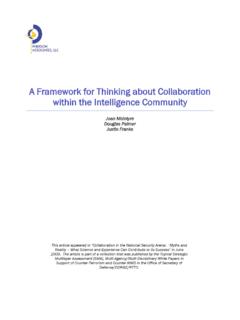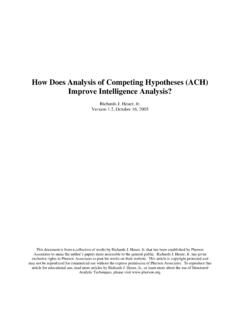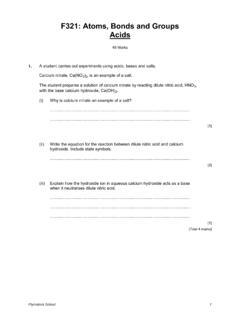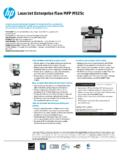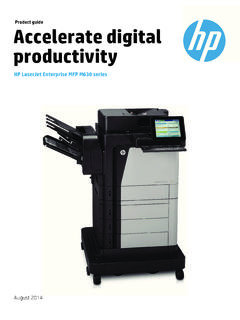Transcription of America’s Increased Vulnerability to Insider …
1 LISA A. KRAMER and RICHARDS J. HEUER s Increased Vulnerability toInsider EspionageBecause espionage is a secret activity, it is not possible to know how manyspies are currently active in American organizations or exactly what thefuture will bring in terms of discovered espionage cases. Nevertheless, it ispossible to explore Vulnerability to the crime of Insider espionage byexamining known factors that, on the basis of past experience, can serve tomake Insider espionage more or lesslikely to occur. A recent study hasidentified technological, social, and economic trends that are serving toincrease the opportunity and motivation for Insider for espionage consists of access to classified or proprietaryinformation that can be exchanged for money or other benefits, access toforeign entities interested in obtaining this information, and means fortransferring this information to foreign recipients.
2 Motivation, broadlydefined, is a feeling or state of mind that influences an individual s choicesand actions. While motivation for espionage results from a complexinteraction between personality characteristics and situational factors,2thefocus here is primarily on the latter. If more insiders are encounteringsituations that provide motivation and opportunity for espionage , theLisa A. Kramer is a Project Manager at the Department of Defense PersonnelSecurity Research Center (PERSEREC) in Monterey, California. She has aMaster s Degree in Psychology and a in Sociology. Her researchinterests include Insider espionage , terrorism, counterintelligence, and socialpsychology.
3 Richards J. Heuer Jr., a retired CIA officer, now conductsresearch for PERSEREC on the role of the personnel security system inmitigating the Insider threat. He is the author ofPsychology of IntelligenceAnalysis(Washington, DC: Central Intelligence Agency, Center for theStudy of Intelligence, 1999). The opinions, conclusions, and recommendationsexpressed in this article are those of the authors and do not necessarilyrepresent the views of PERSEREC or the Department of Journal of Intelligence and CounterIntelligence, 20: 50 64, 2007 Copyright#Taylor & Francis Group, LLCISSN: 0885-0607 print=1521-0561 onlineDOI: JOURNAL OF INTELLIGENCE logical conclusion is that United States Vulnerability to this crime AFFECTING OPPORTUNITY FOR Insider ESPIONAGET echnological Advancement in Information Storage and RetrievalTechnological advances in information storage and retrieval are making itincreasingly difficult to control access to classified and proprietaryinformation.
4 The same characteristics of information technology (IT)systems that improve employee productivity also enhance employeecapacity to gather information for the purposes of espionage . Two specifictechnological advances have particularly dramatic implications for spying:the development of large, networked databases with automated searchfunctions and the miniaturization ofdata-storage devices. The increasingdependence upon networked databases exponentially increases the amountof information a single malicious Insider can access. Automated searchfunctions make it possible for Insider spies to locate specific kinds of data for example, information that is of particular value to foreign spies who exploited large organizational databases includeAldrich Ames, Harold Nicholson, Brian Regan, and Robert addition to improved ability to locate specific types of information, rapidadvances in the miniaturization of data storage devices make it easier for aninsider to remove large quantities of information from an organizationwithout being detected.
5 The physical size and cost of memory sticks andflash drives are decreasing, yet the data storage capacities of these devicesare expanding. As the miniaturization of storage hardware continues, theemergence of nanoscale devices devices with structural features in therange of 1 to 100 nanometers is likely. Potential future applications ofnanoscale electronics include tiny data storage devices with capacities thatare 1,000 times greater than those of products nowavailable do not look like data storage devices, but hold substantial sums ofmaterial. For example, the USB Memory Watch appears to be a normaltimekeeping device, but it has a USB cable hidden in the band and thecapacity to store up to 1 megabyte of data around 22,000 pages of Expanding Market for Protected InformationAs a result of America s status as adominant political, economic, andmilitary force, and the increasingly competitive global economy, foreigndemand for protected information is increasing.
6 American insidersnow have access to more types of protected information that can be soldfor profit, and can sell information to a broader range of private andgovernment-sponsored entities than ever before. Insiders working withinAMERICA S Increased Vulnerability TO Insider ESPIONAGE51 AND COUNTERINTELLIGENCEVOLUME 20, NUMBER 1 American biotechnology, aerospace, telecommunications, computer softwareand hardware, advanced transportation, manufacturing, energy research,pharmaceutical, and semiconductor industries have access to proprietaryinformation that foreign businesses and intelligence collectors will paysubstantial sums of money to demand for American proprietary information supplements anongoing demand for classified information pertaining to informationsystems, sensors and lasers, electronics, aeronautics, armaments, energeticmaterials.
7 Marine and space systems, guidance systems, navigation andvehicle systems, signature control systems, space systems, nuclear systemstechnologies, chemical-biological systems, weapons effects andcountermeasures, ground systems, and directed and kinetic addition to foreign government representatives, Americanemployees can now sell protected information to foreign and multinationalcorporations, foreign research and science institutions, freelance agents(some of whom are former intelligence officers), terrorist organizations,revolutionary groups, extremist ethnic or religious organizations, drugsyndicates, and organized crime more allied and friendly countries pursue technologicalinformation, some insiders may find it easier to rationalize committingespionage.
8 Other individuals who consider it reprehensible to sell Americantechnology or military secrets to an avowed enemy of the United Statesmay be less reluctant to sell this information to individuals ororganizations in countries that are viewed as friendly to of Scientific Research and CommerceThe globalization of business and scientific research is expanding theopportunity for espionage by increasing the frequency with which insidersare able to establish and maintain contact with foreigners interested inexploiting their knowledge. Relationships established through participationin joint research and business projects and attendant activities provideopportunities for Americans to share or sell classified information andmake it easier for foreign entities toidentify and recruit Americans withexploitable weaknesses.
9 The frequency and nature of foreign scientific andbusiness relationships also makes it more difficult for security andcounterintelligence personnel to distinguish relationships that present asignificant security risk from those which do in joint business ventures creates an environment that maybe particularly conducive to espionage . According to Deputy AssistantSecretary of Defense Linton Wells, the inclination of those involved inmultinational trade to regard the unauthorized transfer of information ortechnology as a business matter rather than an act of national betrayal or52 LISA A. KRAMER AND RICHARDS J. HEUER JOURNAL OF INTELLIGENCE treason may be business relationships commonly involvediscussions in which sellers and buyers bargain over price, quantity, andquality.
10 Providing sensitive information or working as a technicalconsultant can be a bargaining chip in these on scientific research projects, by its very nature, involvesthe approved exchange of scientific and technical information. Someinsiders participating in these exchanges have access to protectedinformation that should not be shared, yet may find it difficult todetermine exactly which information is protected and which is scientists believe that, in the spirit of furthering scientific discovery,research findings must be data suggests that greater numbers of insiders routinelyparticipate in collaborative international scientific and commercialendeavors.
